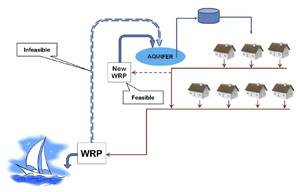By Anthony Herda, Civiltec Engineering
Historically, humans have relied on nature to filter and clean our water supply. We collect wastewater at water reclamation plants (WRPs), treat it, and discharge it out into the environment. From there it evaporates from the oceans, falls to the ground, and collects in streams and aquifers where we tap in to start the cycle over again.
As the population increases and climate patterns change, the pressure on the world’s fresh water sources goes up. Especially in arid regions like the American Southwest, where precipitation is generally low, waiting for rain to refresh our aquifers can be stressful.
To more sustainably and reliably keep our water supply high, water districts are embracing indirect potable reuse (IPR) to recycle their water. Instead of sending treated water out to the ocean and hoping for rain, reclaimed water is returned to local aquifers, increasing groundwater availability at a predictable rate.
California is leading the way with water recycling, with more IPR projects than any other state. The Orange County Water District has long been a pioneer in this work. In 2007 the OCWD completed an upgrade of their groundwater replenishment system (GRS), which is now capable of producing 130 million gallons per day (MGD) and serves a population of 2.3 million.
As urban centers grow, WRPs must grow too. Water districts with limited funds must determine whether it makes more sense to increase the capacity of existing WRPs or build additional facilities closer to the aquifer to implement IPR. Civiltec Engineering, a firm with offices in Southern California and Arizona, is helping to answer this question by assessing all of the factors involved.
To take advantage of gravity, WRPs are usually built at low elevations. The reclaimed water then has to be pumped back up the hill. Building a secondary WRP closer to the start of the water cycled means that reclaimed water doesn’t have to be pumped as far, saving both energy and funds. The new plant also relieves pressure on the existing WRP, extending its practical service life. These benefits are maximized by careful placement of the secondary WRP, which is determined by extensive engineering and economic calculations.
In Southern California, Civiltec Engineering is currently working to maximize the efficiency of water resources management by introducing secondary WRPs in two areas with similar geographic constraints. The first involves the recharge of aquifers within Six Basins in the vicinity of the cities of La Verne, Upland and Claremont. The second involves the distribution of reclaimed water for irrigation and recharge of the alluvial aquifer in the Upper Santa Clara River Sub-basin at the eastern end of the Santa Clarita Valley.
The demands placed on these aquifers are unsustainable and they must be supplemented with imported water at enormous expense. Furthermore, the capacity of existing centralized recycled water distribution limits the potential for local recharge. With Civiltec’s help, these secondary WRPs will reduce the environmental impact of straining the water cycle beyond its locally sustainable limits.





